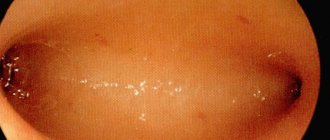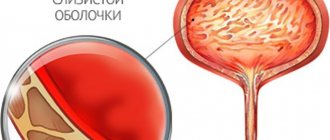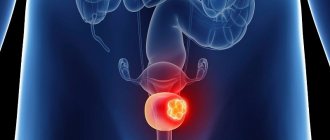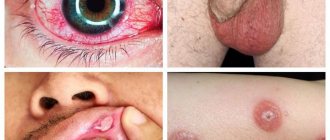The urethra (urethra) is part of a woman's urinary system and a man's urinary and reproductive systems.
In men, the 20 cm long urethra is located both in the pelvis and inside the penis, and opens into an external opening on the glans. Anatomically, the following sections of the male urethra are distinguished: (1) external opening; (2) scaphoid fossa; (3) penile; (4) bulbous; (5) membranous; (6) prostatic (proximal and distal areas).
Figure taken from www.urologyhealth.org
The prostatic urethra passes through the prostate and is divided into proximal and distal parts at the level of the seminal tubercle. In the proximal part of the prostatic urethra, the excretory ducts of the prostatic glands open at the orifices along the posterolateral surfaces. On the sides of the seminal tubercle are the mouths of the right and left ejaculatory ducts, through which sperm enters the lumen of the urethra from the seminal vesicles and vas deferens. In the distal part of the prostatic part and in the membranous part of the urethra there are elements of the urethral sphincter. Starting from the bulbar region, the urethra passes inside the corpus spongiosum of the penis. The bulbar region is located inside the bulb of the corpus spongiosum. In the membranous and bulbar sections, the urethra bends anteriorly upward. In the penile region, the urethra is located medially along the ventral surface of the penis downward from the cavernous bodies. The capitate part of the urethra is located inside the head of the penis. The inner surface of the male and female urethra is covered with mucous membrane (transitional epithelium, with the exception of a short area near the external opening, where there is flat non-keratinizing epithelium).
Structural features
The structure of the urethra, which is called the urethra, differs according to a particular gender:
- In women, the urethra is short - 3-4 cm and wide - 1-1.5 cm.
- In men, the urethra is long – up to 30 cm and narrow – up to 8 mm. In addition, it has curves.
The anatomical features of the structure of the organ are the reason why women often develop cystitis. This is explained by the fact that the infection quickly penetrates the bladder through the short urethra and causes inflammation. In men, the urethra is connected to the vas deferens, so the secretion of the sex glands is also excreted through the urethra.
The inner surface of the urethra is covered with mucous membrane. When it becomes inflamed, which can be caused by various reasons, urethritis develops. In women, this pathology does not lead to disruption of the outflow of urine, which eliminates the occurrence of severe discomfort and speeds up treatment of the disease. Due to the anatomical features, the infection in the male urethra lingers for a long time, causing severe swelling of the mucous membrane. This leads to disruption of the outflow of urine, and in severe cases to painful retention of urination.
WHAT IS THE MENSTRUAL CYCLE AND HOW DOES IT OCCUR?
Our ancestors considered the Moon a symbol of the feminine principle. And all because the female body, like the “night star,” lives in cycles of 28–29 days. These cycles are called menstruation, or menstruation. Each menstrual cycle consists of three phases:
- follicular;
- ovulatory;
- luteal
Normally, menstrual cycles follow one after another. Once a month, a woman’s body prepares for pregnancy, regardless of her own desire. Typically, the first period comes at 11–16 years of age. They are called menarche.
FOLLICULAR PHASE
In the first days of the follicular phase, the pituitary gland, a gland located in the brain, begins to actively produce two hormones: follicle-stimulating hormone (FSH) and luteinizing hormone (LH). They enter the blood and reach the ovaries. Under the influence of pituitary hormones, the maturation of 15–20 follicles (vesicles with eggs) begins in the ovaries and the synthesis of estrogens increases.
Over time, one of the follicles becomes dominant and continues to mature, the rest die.
The dominant follicle continues to produce estrogens. When their levels rise to certain values, they, according to the feedback principle, suppress the production of follicle-stimulating hormone.
The follicular phase lasts approximately 14 days. After this, ovulation occurs.
OVULATORY PHASE
Under the influence of estrogens, the production of luteinizing hormone increases. This causes the dominant follicle to mature, burst, and release an egg. First it enters the abdominal cavity, and from there into the fallopian tube. The release of an egg from the ovary is called ovulation.
The lower part of the cervix begins to produce a lot of mucus - it is needed to help sperm penetrate the uterus and meet the egg.
LUTEAL PHASE
The luteal phase begins immediately after menstruation and lasts approximately 2 weeks. The follicle, after the egg has left it, turns into a structure called the corpus luteum. It secretes the hormone progesterone, which prepares the uterus for pregnancy.
Under the influence of progesterone, the uterine mucosa grows, swells, and blood vessels grow in it. The situation can then develop in one of two ways:
- If the egg meets the sperm and fertilization occurs, the embryo attaches to the wall of the uterus and begins to develop. From this moment on, the woman is considered pregnant.
- If pregnancy does not occur, the level of hormones gradually drops, against this background the uterine mucosa is torn away and exits through the vagina along with blood. Menstruation begins. After it, the follicular phase of the new cycle begins.
Causes of inflammation
Understanding what the urethra is in women and men, one can understand how inflammatory processes occur in the organ. It can be caused by infectious and non-infectious factors.
Non-infectious urethritis often occurs with the development of urolithiasis. In this case, small stones move with the urine current, which can damage the mucous membrane of the urethra, which causes inflammation. Also the cause of the development of non-infectious urethritis are:
- Injuries. They most often occur during cystoscopy and catheterization.
- Tumors. Malignant neoplasms always cause inflammation of the mucous membrane.
- Allergy. Negative body reactions can be caused by negative reactions of the body to certain foods or substances.
Inflammatory processes in men can occur when the urethra is narrowed due to prostatitis or benign prostatic hyperplasia. In such cases, urinary stagnation occurs.
Non-infectious urethritis must be treated in the early stages of development. To do this, on the recommendation of a doctor, you should buy the necessary medications at the pharmacy to relieve inflammation. If therapy is not carried out quickly, infection may occur and complications may arise.
Infectious urethritis can be caused by various pathogens. Before treating the disease, it is necessary to conduct research aimed at determining the type of pathogen. Nowadays you can buy various medications in pharmacies that will quickly overcome the most severe infection. But at the same time, it is necessary to urgently take the required measures. The infection that causes the development of urethritis can enter the body sexually or hematogenously.
Why does the urethra become inflamed in women?
Urethritis, depending on the etiological factor, can be non-infectious (chemical, allergic) and infectious.
But in the vast majority of cases, urethritis is sexually transmitted, and the incubation period of infection can last up to several months.33, 62 Inflammation can be caused by uropathogens such as chlamydia, ureaplasma, trichomonas, gonococci, streptococci, E. coli, and Candida fungi. Inflammation can develop primarily directly in the mucous membrane of the urinary canal or penetrate into it from nearby foci of infection. The general condition of the organism plays a significant role in pathogenesis.33, 62
Symptoms
At the initial stage of development, urethritis does not manifest itself with severe symptoms. Almost always, men experience slight discomfort in the penile canal, and women experience slight discomfort in the lower abdomen, slightly above the pubis. Such symptoms often go unnoticed.
As a rule, patients consult a doctor when the disease becomes acute. This is manifested by severe pain and burning when urinating. There is also a frequent urge to urinate, but the bladder cannot be emptied completely. In severe cases, the following symptoms are noted:
- Cloudy urine, possible inclusions of blood and mucus;
- Purulent discharge with an unpleasant odor.
In addition, a symptom of inflammation of the urethra is redness:
- In men, the external opening of the urethra.
- In women, the labia majora and minora.
Urethritis in women: symptoms and treatment with medications
To treat infectious inflammation of the urethra, antibacterial therapy is used, which is based on the sensitivity of the identified uropathogens to the drugs used. As part of therapy, antibiotics of different groups can be used, and their choice depends on the severity and form of the disease.33
When treating nonspecific urethritis (caused by Escherichia coli, gardnerella, enterobacteria, streptococci), it is recommended to take antibacterial drugs in combination with agents that potentiate their effect. These can be multivitamins, immunomodulators, biostimulants, as well as anti-inflammatory drugs. In case of acute inflammation, urethral instillations are indicated.33
During active therapy, it is necessary to follow a diet (exclude spicy foods, alcohol and other irritating foods), and sexual abstinence. You should also follow the drinking regime.
With timely detection and adequate treatment, the prognosis is usually favorable. But in advanced cases, especially with chronic urethritis, complications may occur (narrowing of the urethra, infertility).33
Diagnostics
In order to purchase effective medications in order to carry out effective treatment that will quickly restore the condition, you need to conduct a diagnosis. The general analysis of power is indicative. Elevated leukocytes in its results indicate the presence of an inflammatory process. Similar deviations from the norm are also observed during a general blood test.
To confirm the diagnosis, smears from the urethra are examined. Biomaterial is collected from the affected area using a special instrument. For the most effective antibacterial treatment, bacteriological urine culture is performed. With its help, the causative agent of the disease is determined. If a viral infection is suspected, a PCR test is additionally prescribed. Also, on the doctor’s recommendation, various instrumental examinations may be prescribed.
Differential diagnosis of urethral inflammation in women
Many diseases of the urinary system have similar symptoms, but their treatment tactics are different. Therefore, it is important to distinguish urethritis from other pathological processes affecting the urethra.33
The diagnosis is often made based on a history of sexual intercourse, as well as microscopic examination of urethral discharge. In addition to the infectious agents, other cellular elements are also identified, which make it possible to determine the etiology and pathogenesis of the disease.33
As part of the diagnosis, bacteriological examination and PCR diagnostics are required. In some cases, urethroscopy (a thorough examination of the urethra using a urethroscope) may be used, but only if there are no signs of acute inflammation. For topical diagnosis, a multi-glass urine sample is of particular importance. 33
Treatment
In most cases, treatment of urethritis does not require hospitalization. Therapy is carried out at home with medications recommended by the doctor. To monitor the dynamics of treatment, it is necessary to periodically visit the clinic during the treatment process.
If a bacterial infection is confirmed, therapy is carried out using antibacterial drugs. These can be pills, intramuscular or intravenous infections. Women can also use vaginal suppositories. When treating men, instillations may be prescribed. During the procedures, a medicinal substance is infused through a catheter into the urethra.
With proper and rapid therapy using highly effective medications, which can now be purchased inexpensively in pharmacies, a positive result is guaranteed in the shortest possible time. In the absence of correct timely treatment, urethritis quickly becomes chronic.
How to cure urethritis in women at home?
Independent choice of treatment for urethritis is not allowed and should only be carried out by a specialist. For the complex treatment of infectious and inflammatory diseases of the urinary system, herbal preparations are often prescribed along with antibiotics. One of them is Fitolysin® paste for the preparation of an oral suspension (hereinafter referred to as Fitolysin®), which contains 4 essential oils and a condensed extract of a mixture of plant raw materials (9 components).6
Phytolysin® has anti-inflammatory, antispasmodic, diuretic effects. It helps relieve pain caused by inflammation, reduce the frequency of urination, and also relieves inflammation.6
The herbal diuretic is available in an easy-to-use form (paste for preparing an oral suspension), which greatly simplifies the dosage. The drug is recommended to be taken 3-4 times a day for 2-6 weeks. If necessary, the course of treatment can be extended, but only after consultation with a specialist.6
Questions about the article
Pauline
December 13, 2021 at 16:40
Hello, please tell me, can nulliparous girls also have urethral transposition or fillers? What's better?
Anton Evgenievich Rotov
December 14, 2021 at 10:55 am
It is not entirely correct to compare fillers and urethral transposition. Still, transposition is a much more complex and effective method of treating postcoital cystitis. There are no restrictions for nulliparous women, but you should not have surgery less than a year before giving birth
Hope
November 4, 2021 at 08:08 pm
Tell me, is it better to have surgery before or after pregnancy? Or maybe right after giving birth? While recovery is going on? Third pregnancy, cystitis began. I scold myself for not having surgery before pregnancy. But I reassure you that often after childbirth the urethra dropped again
Anton Evgenievich Rotov
November 4, 2021 at 08:11 pm
It is better to do the operation definitely after childbirth, after complete recovery (I advise no earlier than 6 months). Now I advise you to gradually train the muscles of the perineum. And also monitor the microflora of the vagina. If done before childbirth, then no later than a year.








